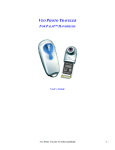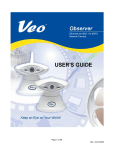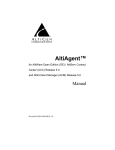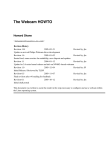Download Veo Connect User`s guide
Transcript
Table of Contents Welcome to the VeoTM Connect/Advanced Connect ................................ 1 A Quick Look at the Veo Connect/Advanced Connect ............................. 2 Minimum System Requirements ................................................................ 3 Software and Installation ............................................................................ 4 How to Connect the Veo Connect/Advanced Connect ............................. 5 The Veo Digital Studio Application ......................................................... 5-6 Taking a Snapshot .................................................................................... 6-8 Recording a Video .................................................................................. 8-10 Recording an Audio Clip ...................................................................... 10-11 Importing Pictures from Another Source ................................................ 11 Importing Files to a Folder in the Digital Studio ..................................... 11 Viewing Pictures in the Gallery ................................................................ 12 E-Card Creator - Creating an E-Card ..................................................13-15 Movie Maker - Making or Editing a Movie ........................................... 16-19 Hompage Designer - Designing a Homepage ....................................20-25 Applying Text, Images, Videos, and Animated Characters ..............26-28 Configuring Your E-mail Program to Send Files ............................... 29-30 Keep In Contact - Videoconferencing .................................................31-43 Troubleshooting ................................................................................... 44-49 Additional Help and Resources ................................................................ 49 Statement of Limited Warranty ................................................................. 50 Welcome to the VeoTM Connect and Advanced Connect The Veo Connect and Advanced Connect Digital PC Cameras are terrific cameras for communicating more effectively over the Internet. Share digital photos in seconds. Send video clips in a snap. Videoconference with ease. The camera application also allows you to create E-Cards, design homepages, and make movies. With the Veo Connect and Veo Advanced Connect, contact anyone...with ease! The Veo Connect package includes: Veo Connect PC Camera 6-foot USB Cable This User's Guide Veo Connect/Advanced Connect CD-ROM The Veo Advanced Connect package includes: Veo Advanced Connect PC Camera Veo Spider Clip 6-foot USB Cable This User's Guide Veo Connect/Advanced Connect CD-ROM 1 A Quick Look at the Veo Connect/Advanced Connect Veo Connect Veo Advanced Connect 2 Minimum System Requirements Hardware • PC with an AMD K6 or Pentium class processor that operates at 300 MHz or faster • 32 MB or more RAM • 200 MB of available hard drive space • CD-ROM Drive • One available USB port on your computer to plug in the camera • Display adapter capable of 800x600 in 16 bit color • Standard microphone for sending video mail and videoconferencing messages (For Veo Connect only. Veo Advanced Connect has a built-in microphone.) • Internet connection (required for video mail and videoconferencing software) Software • Microsoft Windows 98SE, Me, 2000, or XP • Internet browser application, i.e. Microsoft Internet Explorer, AOL • E-mail program, i.e. Microsoft Outlook Express, Yahoo! E-mail, AOL NOTE: To find the version number of your Windows operating system, select Settings from the Windows Start menu. Open Control Panel, and double-click on the System icon. The System Properties dialog box indicates the version number. 3 Software and Installation Install the software before connecting your Veo camera! If you have already plugged the camera into the computer, please unplug it before installing the software. 1. Insert the Installation CD into your CD-ROM drive. 2. Autorun will display the Installation screen corresponding to your camera model. Click Install. 3. On the Install window, de-select any additional software you do not wish to install. Click OK. 4. Follow the prompts to finish the installation. Restart your computer to complete the installation. 5. After your computer restarts, you may plug your camera into the USB port. NOTE: If Autorun does not start, choose Run from the Windows Start Menu. Assuming your CD-ROM drive is the D drive, type “d:\Autorun” in the Run dialog box. If Autorun still does not run, consult your computer manual or manufacturer to locate the CD-ROM drive. 4 How to Connect the Veo Connect/Advanced Connect Plug the USB connector on the camera into any available USB port on your computer. A window should appear and recognize a new device being installed. USB ports USB connector NOTE: If your computer does not recognize a new device installed, please refer to “Troubleshooting” on page 44 in this user’s guide. The Veo Digital Studio Application The Veo Digital Studio is an easy-to-use application that comes with your Veo Connect/Advanced Connect camera. It enables you to take snapshots, record video/audio clips, and manage your files (pictures, videos, music, etc.) It also gives you more flexibility with your pictures and videos by allowing you to make movies, create beautiful E-Cards for various occasions, design creative homepages, and keep in contact with your family and friends. 5 To start Veo Digital Studio, double-click on the icon on your desktop or click on Start > Programs > Veo > Veo Digital Studio. Click to return to Home Screen Digital Studio Home Screen Taking a Snapshot 1. Click the Take A Snapshot button to launch your Veo camera. 2. Focus/adjust as necessary. Use the Small, Medium, and Large buttons to select the desired resolution, then click [ Take a Snapshot]. NOTE: Depending on your camera model, not all resolution settings are available. 3. Click: a) [Retake Snapshot] - To take another snapshot. b) - To save your picture. Select the destination folder and rename the picture if desired. If left unchanged, the picture will be saved in the default directory C:\Program Files\Veo Digital Studio\Gallery\Photographs. 6 NOTE: Depending on your settings, snapshots are captured in either the .JPG or .BMP file format. c) - To send your picture to another person. Type in the requested information. The default name given to the snapshot is MyPicture.jpg. To rename the snapshot before sending, click on the words “MyPicture.jpg” in the attachment text box and click [Rename]. Click to send your snapshot. NOTE: Refer to “Configuring Your E-mail Program to Send Files” on page 29 for instructions on how to configure your E-mail program to send pictures. Snapshot Settings To change the settings of your snapshots, click [Settings]. NOTE: In order for the new settings to take effect, apply before taking a snapshot. Drag to adjust brightness and contrast Choose bitmap or compressed JPEG file formats When self-timer is enabled, select the number of seconds to delay snapshot Restore all settings to default for best overall image quality 7 Advanced Settings Check box to flip images horizontally (mirror image) Recording a Video 1. Click the Record A Video button. 2. Choose: Standard Video - To record and save the video clip to your computer. This file is saved in the .avi file format and can be used in the Movie Maker. Video Mail (Compressed Video for E-mail purposes) - To record and send the video clip to another person. This file is recorded and sent in the .wmv file format. NOTE: You need to have Windows Media Player 7.1 or higher to play back the file. 3. Use the Small, Medium, and Large buttons to select the desired resolution. 8 4. Adjust the volume using the Microphone Volume Adjustment Bar. 5. Click [Record] to record your video. Notice the button turns into [Stop]. Click the Stop button any time to end recording. 6. After the recording stops, the following buttons will appear on the bottom of the screen: [Remove Audio] - Remove sound from your video. [Save Frame] - Save the current frame as a picture file. [Trim Video] - Trim the video to the selected size and length. Drag to select starting/ending point of video [Play] - Play the video. [Rerecord Video] - Rerecord the video if you are not satisfied with the one you just recorded. NOTE: Video Mail does not allow you to remove audio, save frame, or trim video. 7. If recording a Standard Video, click to save your video. 8. If recording a Video Mail, click to email your video. Type in the requested information. The default name given to the video is MyVideo.wmv. To rename the video before sending, click on the words “MyVideo.wmv” in the attachment text box and click [Rename]. Click to send your video. You can also save the file and send it later. 9 NOTE: Refer to “Configuring Your E-mail Program to Send Files” on page 29 for instructions on how to configure your E-mail program to send video mail. Video Settings [Settings] - Click this button to change the settings of your videos. In order to use the built-in microphone for Veo Advanced Connect, select USB Audio Device from the Audio Source pull-down menu. NOTE: In order for the new settings to take effect, apply before recording. Recording an Audio Clip 1. Click the Record An Audio Clip button. 2. Adjust the volume using the Microphone Volume Adjustment Bar. Click [Record] to record your audio. Notice the button turns into [Stop ]. Click the Stop button any time to end recording. 3. After the recording stops, the following buttons will appear on the bottom of the screen: [Adjust Volume ] - Adjust volume of audio clip. [Trim Audio] - Trim the audio clip to the selected size and length. Drag to select starting/ending point of audio [Play] - Play the audio clip. [Rerecord Audio] - Record another audio clip. 10 4. Click: a) - To save your audio clip. b) - To email your audio clip to another person. NOTE: Refer to “Configuring Your E-mail Program to Send Files” on page 29 for instructions on how to configure your E-mail program to send audio clips. Audio Settings [Settings] - Click this button to change the settings of your audio. In order to use the built-in microphone for Veo Advanced Connect, select USB Audio Device from the Audio Source pull-down menu. NOTE: In order for the new settings to take effect, apply before recording. Importing Pictures from Another Source 1. Click Other Source Inputs > Scanner. 2. Select your source, then click Select. Your scanner (or other TWAIN compatible device) software will start. Importing Files to a Folder in the Digital Studio 1. Click Other Source Inputs > File Import. 2. Click to locate the file you want to import. 3. In the Destination pull-down menu, click to select the folder or subfolder that you want the file to be imported to. 4. Click OK to import the file to the destination folder. 11 Viewing Pictures in the Gallery 1. Click the View Gallery button. The Gallery Display Panel opens up. 2. Select a folder to view its content. The following are buttons and folders used in the Gallery Display Panel along with their description: [Min/Max Gallery] - Toggle button used to minimize or maximize the Gallery Display Panel. [Thumbnail Size] - To change the size of the thumbnails displayed in the gallery. [Sort By] - To sort the thumbnails by type, time, or name. You can also use this to search for a file in the Digital Studio Gallery. When you are done searching, all the matched files will be stored in the Search Results folder. Folders: Animations - Contains animated character files. Photographs - Contains still pictures. Graphics - Contains background graphics. Videos - Contains video files. Music - Contains audio clips. Projects - Contains all your previously saved projects. To display the details of a specific file, click [Properties]. NOTE: To delete a file, click on the file and click into the [Delete]. Do NOT drag it . 12 E-Card Creator - Creating an E-Card 1. Click on the E-Card Creator button on the Digital Studio Home Screen. 2. Choose to Create A New Card or Find A Previously Saved Card Project. If you choose to open a previously saved project, you may click on the following options: to get 3. If you are creating a new card, select a theme from the left panel, then select the background for your E-Card. Click Continue. 4. Edit your card. (See “Applying Text, Images, Videos, and Animated Characters” on page 26 for more on editing a card). If you are using a predefined E-card layout, you will see a screen similar to the one below: Double-click to change image 13 Double-click to edit text Click Continue when you are done. 5. Define your animated characters’ path. (See page 28 for more on how to define the path of an animated character). Click Continue when finished. 6. Select the background music. Click [Set Background Music]. 7. Choose your background music. To listen to the music before selecting, place your cursor on any one of Click without clicking. [ Mute] to turn background music on and off. NOTE: When you change the Mute button to , it does NOT remove the background music. You just will not be able to hear it. To remove the music entirely, click [Set Background Music] and choose After you select your music, click Continue. . 8. Click [Transition Effect]. Sample the effects by placing your cursor above each individual effect. 9. Choose the opening effect (how you want the E-Card to open up). Click Continue. 10. To preview the E-Card, click [Preview]. To save the E-Card for editing later, click [Save]. To save the E-Card as a separate file, click [Save As]. 11. Type in the requested information. In the Attach Card As pull-down menu, select A Video (*.wmv) if the person you are sending the card to has Windows Media Player. 14 12. The default name given to the E-Card is *.exe where ( * ) is the name of your E-card background you picked in step 3. To rename the E-Card before sending, click on *.exe in the attachment text box and click 13. Click [Rename]. [Send This Card] to send your E-Card. NOTE: Refer to “Configuring Your E-mail Program to Send Files” on page 29 for instructions on how to configure your E-mail program to send ECards. 15 Movie Maker - Making or Editing a Movie 1. Click on the Movie Maker button on the Digital Studio Home Screen. 2. Choose to Create A New Movie or Open An Existing Movie Or Project. If you choose to open an existing movie, you can click on following options: Save the movie to a specified location to display the Preview the movie 3. Simply drag and drop videos or pictures from the Gallery Display Panel into the Movie Maker. The following are buttons used in the Movie Maker along with their description: [Back] - Go back to previous screen. [Continue] - Continue to the next screen. [Save Finished Movie] - Save your movie at any time in the process. [Preview Complete Movie] - Preview the movie you have created. [Add A New Scene] - Add a new video or picture to your movie. You can either add an existing video/picture from your computer or record a new 16 video/picture from your Veo camera for insertion. In order to add from your camera, make sure it is connected to your computer. NOTE: For more on how to take snapshots or record videos, refer to “Taking a Snapshot” on page 6 and “Recording a Video” on page 8 of this user’s guide. [Add Background Music] - Add music to your movie. [Remove Music] - Remove music from your movie. When you are done, click Continue. NOTE: By default, still pictures will be shown in the movie for three (3) seconds. To change the duration of pictures in the movie or view other options, click . The following box appears: Edit selected scene Duplicate the scene Change duration of scene and other options Delete the scene 17 Select Scene Duration. Select duration time Option: - Remove Audio (Video files only) - Set background color - Zoom to fit screen Save changes NOTE: Video (.avi) files also have a [Trim Video] button that allows you to adjust the size and length of the video. Refer to page 9 for more on how to trim video. Click Continue when you are done. 4. Select a scene from the bottom and click [Transition Effect]. 5. Sample the effects by placing your cursor above each individual effect. Choose the opening effect (how one scene changes to another). 6. Double-click on the remaining scenes in the Movie Maker, then repeat steps 4 and 5 above to apply opening effects to the remaining scenes. Click Continue when you are finished. 7. Select a scene to edit by double-clicking on the scene in the Movie Maker. Make sure the scene shows up in the Main Screen. 8. Edit the selected scene. (See “Applying Text, Images, Videos, and Animated Characters” on page 26 for more on editing a scene). Click Continue when you are done. 18 9. Repeat steps 7 and 8 to edit the remaining scenes. When you are finished, click Continue. 10. a) To preview the complete movie, click b) To save the movie for editing later, click [Preview]. [Save]. c) To save the movie as a separate file, click [Save As]. d) To save the movie on your computer, click Save Finished Movie. e) To send your movie to a friend: 1) Click E-mail Movie To A Friend. 2) Type in the requested information. 3) The default name given to the movie is Default.wmv. To rename the movie before sending, click on the words “Default.wmv” in the attachment text box and click [Rename]. 4) Click to send your movie. NOTE: Refer to “Configuring Your E-mail Program to Send Files” on page 29 for instructions on how to configure your E-mail program to send movies. 19 Homepage Designer - Designing a Homepage 1. Click on the Homepage Designer button on the Digital Studio Home Screen. 2. Choose to Create A New Homepage or Open A Previously Saved Homepage Project. If you choose to open a previously saved homepage project, you may click on Save webpage to your computer to get the following options: Publish webpage to your Internet Service Provider 3. If you are designing a new homepage, select a theme from the left panel, then select the background for your homepage. Click Continue. 4. Edit your homepage. (See “Applying Text, Images, Videos, and Animated Characters” on page 26 for more on editing a card). To add a new page at any time, click [Add A New Page]. Click Continue when you are done. 5. Define your animated characters’ path. (For directions, please refer to page 28). Click Continue when you are finished. 6. Select a picture or animated character. 20 [Link All Pages] - Check the box to the left if you want all pages to be linked. Notice that if you check the box to the left of the Link All Pages icon, it will turn into . It means that all your pages are successfully linked. When you previewing the webpage, you will see that there are two arrow buttons on the bottom for easy navigation between pages. If you have text or pictures on the very bottom, they might be partly covered. Try placing the text/pictures higher on the page. Click to go to previous page Click to go to next page [Page Link] - Link an object/image/page to another page. Linking to Another Page If you want to include a function on your page that allows you to click on a text/picture to link to other web pages, follow the steps below: a) Select the text or picture on the Main Screen that you want to link . b) Click on 21 [Page Link]. c) Select to link to an existing page or to a page on the Internet. If linking to a page on the Internet, type in the address (URL) of the website, then click OK. Alternatively, you can click on [Actor Interaction]. Anchor Actors Container Storyboard Container URL - Link to a page on the Internet Use the Up and Down buttons next to the Anchor Actors Container to select the image/text you want to link. Then: a) Drag a page from the bottom panel into the Storyboard Container to link to one of your existing pages. -ORb) Click [URL], type in the address of the webpage on the Internet, then click OK. NOTE: When using Homepage Designer, animated characters do NOT automatically move along its path by default. You need to click on it in 22 order for it to start. Refer to the next section on how to automate this process. Automating Animated Characters in Homepage Designer a) Click [Actor Interaction]. b) Make sure the Anchor Actors Container has AutoPlay selected. If not, use the Up and Down arrows to select it. Autoplay c) Select the animated character that you want to automate and drag it from the right panel into the Storyboard Container. Repeat the same procedure for other animated characters. Click Exit when you are finished. 7. Select the background music. Click [Set Background Music]. 8. Choose your background music. To listen to the music before selecting, place your cursor on You may click 23 without clicking. [Mute] to turn the background music on and off. NOTE: When you change the Mute button to , it does NOT remove the background music. You just will not be able to hear it. To remove the music entirely, click [Set Background Music] and choose . After you select your music, click Continue. 9. Select opening effect by clicking [Transition Effect]. 10. Choose the opening effect (how one page changes to another). 11. Double-click on the remaining pages in the Homepage Editor, then repeat steps 9 and 10 above to apply the opening effect to the remaining scenes. Click Continue when you are finished. 12. a) To preview the page, click [Preview]. b) To save the page for editing later, click [Save]. c) To save the page as a separate file, click [Save As]. 13. Choose: Add a New Page - To add and edit a new page. -OREdit Next Page - To edit the next page. -ORPublish Now - To publish the homepage to your Internet Service Provider. Publishing the webpage to your Internet Service Provider To publish your webpage, you need to be connected to the Internet. Fill in the requested information, then click Publish. You will be prompted to type in your user name and password to access the site for publishing. 24 Site name Full Internet name New site Edit selected site Remove selected site Enter sub-directory name Enter default name of homepage Publishing the webpage to your computer a) Click on Publish The Files To The Hard Disk. b) Select the destination and rename the file if desired. The webpage along with all supporting files (i.e. images, music, etc.) will be saved as a folder instead of a single file. c) Click View A Local Copy of the Page Just Published to view your webpage. Alternatively, you can open the folder that you saved, and doubleclick on the file named index. NOTE: DO NOT move or delete any items in the web folder. Otherwise, you might experience problems viewing the pages. 25 Applying Text, Images, Videos, and Animated Characters Adding and Exiting Text a) Click [New Text] to add new text to the scene/page. b) Double-click on the text to edit it. A screen similar to the one below appears” Preview font Type text in here Select font color Select font Apply effects to font The following are the application buttons and their description: [Insert Video] - Insert a new video clip. [Insert Image] - Insert a new image. Alternatively, you can drag and drop images/videos from the Gallery Display Panel into the Main Screen. 26 [Animation Path] - Define the path of the images or animated characters (the path an object will follow to move from point A to point B). [Sequential Animation Sequence] - Animations move one after another depending on which one you inserted first. [Simultaneous Animation Sequence] - All animations move at the same time. Editing an Image or Animated Character Flip image horizontally (mirror image) Return image to original size. Display more commands Flip image upside-down Drag to resize image When you click , the following box appears: Duplicate the image Delete the image When images overlap, select to bring image to the back When images overlap, select to bring image to the front Add a sound effect to the image Change to another image 27 Adding Sound Effects to an Animated Character You can add a sound effect to an animated character either by inserting a .wav file from the Sound Effects folder or from your microphone (i.e. if you want to record your voice). To insert sound from your microphone, click the From Microphone tab. See “Recording an Audio Clip” on page 10 for more details on how to record and edit audio clips. When you are done, click . NOTE: Sound Effects are only applied when the animated character is moving along its defined path. If you have not defined a path, the sound effect will be disabled. Defining the Path of an Animated Character (also works with a still picture). a) Select the image or animated character that you want to move. b) Click [Animation Path]. Notice the animated character now follows the mouse cursor. c) Select the starting point (where you want the animated character to start moving from). Hold the left mouse button down, then freely drag the character along a path you specify to the ending point (where the character finally stops at). Your selected animated character will follow this path 28 Configuring Your E-mail Program to Send Files In order to send your files directly from the Veo Digital Studio, you must change your default mail agent, otherwise known as Messaging Application Program Interface (MAPI). For E-mail programs that do not support MAPI (i.e. AOL, web-based E-mail programs), you need to attach the files manually. For further assistance on how to attach files to your E-mail, contact your Email or web-based E-mail provider. Using MAPI with Microsoft Outlook Express 5/6 1. Start Microsoft Outlook. 2. Go to Tools > Options. 3. Click Make Default under Default Messaging Programs - This application is NOT the default Mail handler. 4. Restart your computer. Using MAPI with Microsoft Outlook Microsoft Outlook automatically sets up your MAPI E-mail program during installation. Make sure your Microsoft Outlook E-mail application is properly set up with the right POP account name, password, SMTP mail host account, and other requirements. For further assistance, contact your Internet Service Provider (ISP) or systems administrator. Using America Online or Web-based E-mail Programs to Send Files AOL does not support MAPI functions. If you click on the Send button, it will not work. To send E-mail your files, follow the steps below: 1. Start America Online or log in to your web-based e-mail. 2. Compose a new e-mail message. 29 3. Depending on your web-based email service, look for the Attach, Attachments, or Insert option to attach your file. You will be prompted to browse for the desired file you want to attach. Change the directory to where you saved your file (i.e. C:\Program Files\Veo Digital Studio\Gallery\...) and attach the file(s). 30 Keep In Contact - Videoconferencing 1. Click Keep In Contact on the Digital Studio Home Screen. This will minimize your Veo Digital Studio window and launch Microsoft NetMeeting. Microsoft Windows Messenger Guide Microsoft Windows Messenger has been included with Microsoft Windows XP to provide the latest in point-to-point videoconferencing. To ensure that you obtain the most from your camera experience, we have compiled this brief instruction guide to help you get started. Note that this guide is provided only as a reference and is not endorsed by Microsoft. To obtain additional assistance with Microsoft Windows Messenger beyond what is outlined in this guide, refer to the support options on page 42. 2. If you have already set up Windows Messenger, you will be prompted with the sign-in screen. Enter your e-mail address and password, then click OK. For example, any address ending in @hotmail.com or @msn.com can be used. 31 3. Windows Messenger will sign you in. 4. The people on your contact list will appear. If you want to connect with another user for videoconferencing, you will need to add them to your contact list, using the Add button. Follow the rest of the directions in Windows Messenger to add people to your contact list. Using Windows Messenger for Videoconferencing Double-click on the person’s name that you would like to connect with. A conversation window will appear where you can do the following: Start camera - Turn on your camera for videoconferencing Start talking - Use your microphone to talk to another person 32 Send a file - Transfer a file to another person Text messages - Type text messages to another person Starting your camera Make sure that no other program is using your camera. If you have any other PC Camera or videoconferencing software that is already in use, make sure to close these programs first. To turn your camera on, click the “Start Camera” button. The text message window will also display the message, “You have asked to have a video and voice conversation. Please wait for a response or Cancel (Alt+Q) the pending invitation.” The other person who sent the invitation to join the video and voice conversation will see the screen shown on the next page, with the message: “I would like to have a video and voice conversation with you. Do you want to Accept (Alt+T) or Decline (Alt+D) the invitation?” 33 The other person has a choice of clicking Accept or Decline to begin the video and voice conversation. Once connected to the other person, your screen will appear similar to the image pictured. The other person’s video will appear in the large video window, while your own video will appear in the lower right corner as a Picture-inPicture window. If you have a soundcard and microphone, the options for voice will also be available. You have the options to adjust your speaker volume or mute the microphone. 34 Microsoft NetMeeting Guide Microsoft NetMeeting has been included with your camera to provide videoconferencing capabilities. As one of the most widely distributed and versatile videoconferencing applications on the market, you will be able to communicate with anyone in the world as long as all parties are connected through Microsoft NetMeeting. As a result of its large distribution base, you will find that most owners of a pc camera will already have some exposure to the software and probably own a copy. Although this is an excellent program to become acquainted with, it can be rather complicated the first time you set up a conference. To ensure that you obtain the most from your camera experience, we have compiled this brief instruction guide to help you get started. However, since this is a Microsoft program we cannot offer any support for this product beyond what is outlined in this guide. To obtain additional assis- 35 tance with Microsoft NetMeeting, directly from Microsoft, please refer to the NetMeeting web site at: http://www.microsoft.com/windows/netmeeting. How to use Microsoft NetMeeting Once you have all the necessary components of Microsoft NetMeeting installed and tested to ensure it is working properly, this section of the guide will provide some basic tips on videoconferencing. IMPORTANT: Make sure any other video camera applications are closed before starting Microsoft NetMeeting. 1. Click Keep In Contact on the Digital Studio Home Screen. 2. If you have Microsoft NetMeeting already set up, you will see a window similar to the one shown below: 3. Turn your camera on by clicking the Play/Pause button to initiate the video stream (this may take up to a minute depending on your computer). Adjust 36 the camera angle and focus to ensure a clear picture of you for your videoconferencing partner. These are the buttons you will use with NetMeeting: Play/Pause your video Picture-in-Picture (Only available when connected to another user) Place a call Adjust microphone and speaker volume End a call Access the Microsoft Internet Directory Advanced Buttons - These advanced features include Sharing a Program, Chat, Whiteboard, and File Transfer. Please refer to the NetMeeting webpage for more details and assistance with these features. Connecting to another NetMeeting user There are a few methods to connect to another user who is using NetMeeting. Connecting to another NetMeeting user is easy via the MSN Messenger service, simply download and install MSN Messenger from Microsoft at http:// messenger.msn.com. Directions for installing and setting up MSN Messenger will be shown on the MSN Messenger webpage. 37 Connecting via MSN Messenger: With MSN Messenger, you can send instant messages to your friends and family if they are online. To start, follow the steps outlined below: 1. Connect to the Internet and then start MSN Messenger. MSN Messenger will indicate the people on your contact list who are online. 2. Double-click on the person you are trying to videoconference with to initiate a text-based conversation. This will bring up a window similar to the interface shown on the following page. You may now have a text-based conversation in this window. 3. Next, click on the Invite button and then select To Start Microsoft NetMeeting. The other person will receive an invitation to start Microsoft NetMeeting. 38 4. If the other person you are connecting to accepts the invitation to start Microsoft NetMeeting, you will automatically be connected. You will receive video in a window similar to the one on the following page. The person who you are calling will appear in the large main window while you will appear in the smaller Picture-in-Picture window. NOTE: If you are using a dial-up connection, the video will move at approximately 5-10 frames per second. Faster Internet connections such as DSL or Cable Modem will result in faster frame rates. This translates into smoother motion and clearer video. 39 Connecting using an IP address To have a direct connection with another user, you must first obtain an IP address. IP addresses for most dial-up connections will change every time you log on to the Internet. For this reason, you must get the IP address from the person you are trying to contact each time. You can also determine your IP address and then send it to the other person who will use NetMeeting to call you. To obtain your IP address, first connect to your Internet Service Provider. Then use either Method A or B to determine your IP address. 40 Method A: Start NetMeeting and then click on Help > About Windows NetMeeting. You can see your IP address here (as shown below). Method B: If you are using Windows 98/Me, click on the Start button > Run > then type: WINIPCFG If you are using Windows 2000, click on the Start button > Run > then type: IPCONFIG You can send your IP address to the person who you are calling or they can send you their IP address by e-mail or through an Instant Messaging application such as MSN Messenger. 41 To connect to a person using their IP address, you can enter it into the highlighted area (as shown below). After you type in the person’s IP address, press Enter on your keyboard to connect. Microsoft Windows Messenger and NetMeeting Support & Resources This guide has been intended to provide a brief introduction to Microsoft NetMeeting. For more in-depth information or to obtain technical support for Microsoft NetMeeting, please refer to the contact information on the following page. The resources listed are third-party sources and are neither endorsed nor supported by the camera manufacturer and have been provided only as a reference. 42 Microsoft Windows NetMeeting: http://www.microsoft.com/windows/netmeeting (800) 936-5700 [Toll Free/Pay per incident] (425) 635-7123 [Toll Call/No charge support] MSN Messenger: http://messenger.msn.com The Windows NetMeeting Zone: http://www.netmeet.net Meeting by Wire: http://www.meetingbywire.com Additional Video Messaging/Conferencing Services Yahoo! and Buddy Vision/AOL also provide Video Messaging/Conferencing solutions. For more information, please contact Yahoo! and Buddy Vision directly: Yahoo! http://messenger.yahoo.com Buddy Vision http://www.buddyvision.com 43 Troubleshooting Problem: The power light does not come on when the camera is plugged in. Solution: The light will come on when you run any of the camera applications, but will not turn on if the camera is just plugged in. Problem: Missing Windows system files. Solution: The Windows system files can be found on the Veo CD. Place the Veo CD into your CD-ROM drive and browse in the D:\Microsoft\WinXXXX folder (where D:\ is the letter of your CD-ROM drive and XXXX corresponds to your version of Windows). Select the files that Windows is asking for and copy them into C:\Windows\System. Some files may still require the Windows CD. Contact your computer vendor to obtain a copy of the Windows CD if one did not come with your computer. Problem: Windows doesn’t detect the camera when you plug it into the USB port. Solution: When you plug in the camera after installing the drivers and software, Windows will detect the camera and begin installing the drivers for your Veo camera. If you are getting no response from Windows when you plug the camera in, this can be a sign that your USB port is not configured properly, is disabled, or has malfunctioned. If your motherboard requires a cable to connect the USB port, make sure that it is plugged in correctly. If you are not sure of the proper configuration, please contact your system or motherboard manufacturer. If your USB controller is not listed in the Device Manager, enable it in your system BIOS. Try using the camera on another system to verify that the camera is working properly. 44 Problem: “Digital Video PC Camera is not connected to this computer” Solution: The camera may not be plugged into the computer or may have a driver conflict. Make sure the camera is snugly plugged into the USB slot on your computer, then try the camera software again. If this doesn’t help, click on Start > Settings > Control Panel > System >Device Manager and check to see if you have a Universal Serial Bus Controller category. Under this category should have a USB Host Controller and a USB Root Hub. If you do not have this category, please contact your computer manufacturer for assistance on enabling your USB ports. If you do have this category, check for another category in the Device Manager named Imaging Device. Under this category should be the Veo PC Camera. If the Veo PC Camera has a yellow “!” or red “X” next to it, this means it may have a problem with the software driver. Double-click on the Veo PC Camera with the yellow “!” or red “X” to check the Device Status. If the camera has a yellow exclamation mark in the Device Manager with the message: “NTKERN.VXD device loader could not load the device driver (Code 2)” please follow either section A (if using Windows 98/98SE) or section B (if using Windows Me): A. Windows 98/98SE: 1) Remove the Veo PC Camera from the Device Manager. (Start > Settings >Control Panel > System > Device Manager > Imaging Device) 2) Unplug the Veo camera from the computer. 45 3) Search for a program named “cleanup” on your computer. The icon should look like this . Double-click it to run the cleanup. Press Scan and Delete to entirely clean up the previous installation of the camera. 4) After the cleanup program has completed, press the Exit button. 5) Uninstall the Veo Connect/Advanced Connect software. (Start > Settings > Control Panel > Add/Remove Programs > Veo Connect/Advanced Connect) and restart the computer. 6) Reinstall the Veo camera software, restart the computer, and plug in the camera. 7) Try launching the Veo camera application again. 8) If this does not work, there could possibly be mismatched versions of the Windows system files. Replace the mismatched files with the files from the Veo Connect/Advanced Connect CD. The correct version of the Windows system files can be found under D:\Microsoft\WinXXXX where XXXX is the operating system you are using and D:\ is the letter of your CD ROM drive. To prevent any problems, backup the files that will be replaced before overwriting the files. These files are also available online at http://www.veoproducts.com. B. Windows Me: 1) Click on a button named Update Driver. Click this button to update the driver. 2) Make sure Automatic search for a better driver. (Recommended) is selected, then press Next. 3) Windows Me will then proceed through a detection process, searching for better drivers. 4) After the detection process you will get this message: 46 “Windows was unable to locate an updated driver for this device, but did find other drivers that should work with this device. You are already using the best driver for this device. What would you like to do? · Continue using the current driver. (Recommended) Veo PC Camera · Install one of the other drivers. - View List” 5) Select Install one of the other drivers and then click View List. 6) There will be a list of 1-4 possible Veo PC Camera drivers. Usually, there will be a few drivers from the CD ROM drive and 1 from the Hard Drive. 7) Select the Veo PC Camera driver that is located on the hard drive (C:\Windows\INF) to update the driver. 8) Press Next and then press Finish. Windows will prompt you to restart the computer. Click Yes to restart the computer. 9) You should now be able to use the Veo camera and software. Problem: “The supplied user buffer is not valid for the requested operation. hr=0x80070618” Solution: Your computer may have mismatched versions of the Windows system files. Replace the mismatched files with the files from the Veo Connect/Advanced Connect CD. The correct version of the Windows system files can be found under D:\Microsoft\WinXXXX where XXXX is the operating system you are using and D:\ is the letter of your CD-ROM drive. To prevent any problems, backup the files that will be replaced before overwriting the files. These files are also available online at http://www.veoproducts.com. 47 Problem: Nothing happens after I click the Send button or the program locks up. Solution: You need to configure your email program to be the default MAPI client correctly. You can also manually attach your files to your e-mail. Please refer to “Configuring Your E-mail Program to Send Files” on page 29 for more information. Problem: “No e-mail agent found on this PC. Do you want to continue with video mail disabled?” message. Solution: You will get this message if the e-mail application you are using does not support MAPI functions such as America Online, CompuServe, Prodigy, Yahoo Mail, and other web-based email service. Programs such as Outlook Express, Netscape Mail, and Eudora support MAPI. However, your mail server needs to be able to use these programs. Contact your Internet Service Provider for assistance on configuring your outgoing mail server. AOL does not let you use third party e-mail programs. If you want to send the VMail that you recorded, you need to save it first. Then, open your e-mail application and attach the V-Mail. Problem: Audio doesn’t work Solution: - Click [Settings] to change the settings of your audio. In order to use the built-in microphone for Veo Advanced Connect, select USB Audio Device from the Audio Source pull-down menu. If you are using an external microphone, make sure your microphone is plugged into your sound card correctly. The microphone jack on your sound card is usually labeled MIC or with a microphone symbol. Also try plugging the microphone into other jacks. Make sure it is not plugged into the speaker 48 or output jack. If this does not work, please refer to your sound card or microphone manuals. Problem: You cannot play back an AVI/EXE video file. Solution: The Windows Media Player you are using may not be working correctly. Download the latest Windows Media Player from Microsoft at http:// www.microsoft.com/windows/mediaplayer. Additional Help and Resources For detailed Technical Support, Frequently Asked Questions, and resources about the Veo Connect/Advanced Connect, the website is accessible directly by clicking the [Online Help] button on the lower right hand corner of the Digital Studio Application. The website is also accessible at the following URL address: http://www.veoproducts.com. For technical support by phone, please call (408) 474-0494. Technical support hours are Monday through Friday from 8:30 am to 5:30 pm Pacific Time. 49 Statement of Limited Warranty Xirlink Inc. warrants that for a period of 2 (two) years from the date of purchase that this product 1) is free from manufacturer defects in materials and workmanship and 2) conforms to its specifications. If this product does not function due to manufacturer defects during the warranty period, Xirlink, Inc., at its option, will either replace this product with one that is functionally equivalent or will refund your purchase price. These are your exclusive remedies under this warranty. Please call (408) 350-8403 for warranty service. This product is distributed and sold by Xirlink, Inc. For all non-technical comments and questions related to this product, please contact Customer Service at (408) 350-8403. Customer Service hours are Monday through Friday from 8:30 am to 5:30 pm Pacific Time. Veo Connect and Veo Advanced Connect are registered trademarks of Xirlink, Inc. All other products and company names mentioned herein are the trademarks or registered trademarks of their respective owners. 50




























































